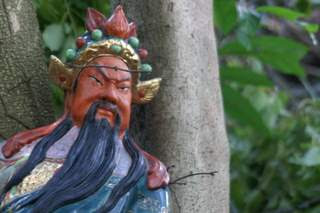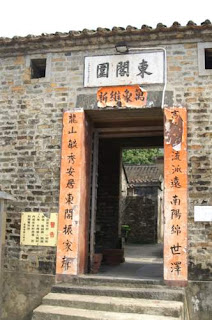 Dear Gentle Reader,
Dear Gentle Reader,Sometimes a protective deity is not enough to keep you safe from the spiders, snakes, and bandits here in Hong Kong.
The famous fighting Shaolin monks always thought that you needed to do more than to rub Buddha's belly; Shaolin monks were also prepared to battle.
I should note that Shaolin monks, from their perspective, do not fight.
Shaolin monks simply refuse to accept violence offered to them and, therefore, they return violent offerings to the sender (postage prepaid).
Shaolin Temple in Henan Province, China is the mythical birthplace of both Chinese kung fu and Zen Buddhism some time after 464 AD (eleven years after Attila the Hun died and nine years after the Huns sacked Rome).
Shaolin monks have had a lot of time perfecting their techniques of returning violent offerings to senders, aka learning to deal with bad guys. Why? Well, apparently, China has had a lot of bad guys.
If John Woo's observations on Hong Kong in The Killer and other films are correct, then residents of Hong Kong need to take some lessons from the Shaolin Monks, or the monks of Smith and Wesson.
John Woo thinks that there are a lot of bad guys in Hong Kong, too.
That life has always been dangerous in Hong Kong, and that extra safety precautions were necessary, were the lessons which we took from a recent walk in the New Territories, part of Hong Kong abutting Mainland China.
This day walk took us through fields, countryside, and a series of old walled villages dating back to the sixteenth century.

Sometimes overgrown with vegetation on the outside, these villages have been clan villages for centuries and we walked to, and through, five walled villages. These walled villages were, and remain, the communal villages for particular clans.
Each walled village had only one entrance/exit inside a gate tower. The doors could be great wooden affairs, consist of iron loops, or be horizontal wooden rods. If you didn't have the secret code, the right last name, entry could become a contact sport.



The single entry made it easier to control access. Further, each entrance guard tower had an upper room for village defenders to fire on outsiders.
Below is a close up of one of the arrow-slits from the inside.

Your humble scribe liked this arrow slit; a classic case of form following function.
Your scribe noted that the Chinese arrow slit allowed for a full horizontal, and some vertical, sweep of the defender's field of arrow-fire.
Your Heroine noted that the hole in the arrow slit was about the same size as your scribe's hand; hopefully an opening this small would have blocked ingress to the giant spiders of the apocalypse.
The villages have developed and become modern, although older buildings, besides the walls, remain.

I assume, however, that new construction is relatively labour intensive, as the village walls, in each village we visited, remain fully intact. (How, for example, would cranes be brought in?)
Finally, while the villages have modernized, we understand that these villages are still the cultural repositories for rituals that have disappeared elsewhere. Your Heroine and I look forward to returning to observe some of the ritual events in these villages at the appropriate times in the Chinese lunar calendar.
Now, however, we are safely back in Hong Kong proper.
Time to lock the doors, throw the bolts, and shutter the windows.
Thank goodness the guards are on duty tonight to keep the bad guys out...
Tschuess,
Chris, Regina, and Pommes mit apprehension









8 comments:
Thanks for the great tour and history lesson! I felt as if I were along for the walk.
Great picture to go along with the descriptions. I like that arrow hole. Seems very functional.
Lovely post, Chris. Seems like another time.
Thanks for the comments Mary, Travis, and Pattinase.
Thanks for this wonderful walk!!!
DO return, if prudent, at festival time. please! moon cakes? lion dancing? red paper with gold good-luck calligraphy?!
Wonderful tour and photos, especially of the ancient walls and fortresses. Chris, you have a considerable amount of history at your disposal for future MTM posts, which I am looking forward to.
Hi Cloudia,
Thanks!
Being rather culturally minded, I am sure that nothing short of travel or work could stop us from heading back to these and other villages for cultural voyeurism.
There are some relatively ancient rituals that are preserved, apparently, in these villages.
These villages have managed to escape the predations of excess found on the Mainland and in Hong Kong. (Cultural repression by force on one hand, cultural repression by obsession on wealth on the other)
Tschuess,
Chris
Hi Barbara,
I am certainly a big fan of history, and therefore of your posts too.
I really enjoy history because of the context it can provide. Further, like you, I believe that history is not only around everywhere, but it ought to be remembered so that events and processes can be contextualised during analysis.
History is, of course, so much more than alleged facts, but, without knowledge of a fact-rich environment it is much harder to move into a defensible analysis of what has happened, is happening, or might happen.
Some national cultures take the remembrance of history to the extreme where revenge is sought for century-old 'wrongs' (the Balkans' collection of sovereignties?) while both Canadian and Americans (2/3's of North America by sovereignty) seem too forgetful in our collective memories.
Thank you, Barbara, for what you do in attempting to redress North American memory loss... and thank you for your compliment.
Tschuess,
Chris
Post a Comment